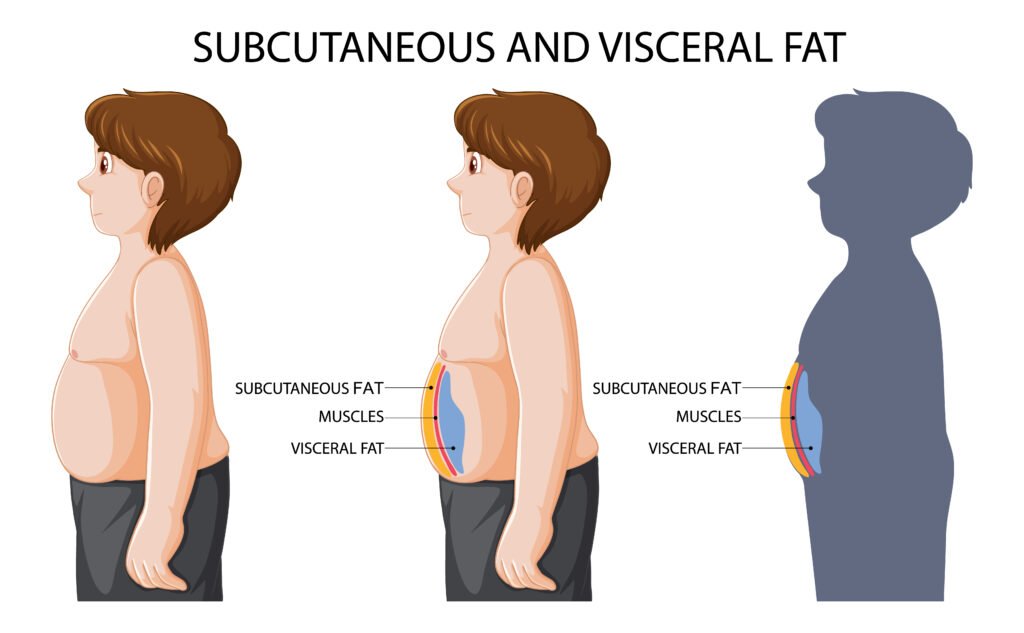
The Real Story of Belly Fat: Understanding Its Causes, Risks, and Solutions
Belly fat is more than a cosmetic challenge; it’s a fitness problem that influences millions internationally. Understanding what belly fat clearly is, what causes it, and the way to control it is able to empower you to steer a more fit existence. Let’s uncover the information in the back of belly fat.
“The Real Story of Belly Fat” is a topic that often raises questions.
Have you ever wondered why losing belly fat seems like an endless battle?
What’s the real story behind those persistent inches around your waistline that refuse to budge, no matter how many crunches you do or diets you try?
We all know that extra flab around the midsection can be quite stubborn. In this discussion, we’ll dig into the facts, debunk some myths, and find out what works to trim that belly bulge and reduce the stubborn belly fat. Get ready to explore the secrets of losing belly fat and improving your health along the way. It’s time to demystify the midsection!
This is normal. Still, inordinate belly fat can impact your health more than other types of fat. Some fat resides just under your skin, while other fat surrounds your organs, like the heart, lungs, and liver, in deeper layers.
Hormones Matter: Unveiling the Real Story of Belly Fat
One of the key secrets behind belly fat lies in our hormones. Hormonal changes, particularly an increase in cortisol( the stress hormone), can contribute to the accumulation of fat in the abdominal area. Hormonal oscillations, particularly in women, can lead to an increase in abdominal fat.
Conditions like PCOS and menopause frequently contribute to hormonal imbalances that affect weight gain around the waist. Understanding these hormonal factors is pivotal for effective belly fat reduction.
In this disquisition of the real story of belly fat, we’ll claw into how hormonal imbalances can be a primary cause of that stubborn belly fat.
Access Now: https://shrinke.me/XpBSNN

This deeper fat, known as” visceral” fat, can be a significant problem, indeed, for thin individuals. Deep-stubborn Stubborn belly Fat You need a specific quantity of visceral fat, as it coats your organs. But having too much of it can increase the risk of high blood pressure, type 2 diabetes, heart complaints, internal diseases, and certain types of cancer, including stomach and liver cancer, especially for those who are thin.
Fat Is Not Just Sitting There According to Kristin Hairston, MD, assistant professor of endocrinology and metabolism at Wake Forest School of Medicine, visceral fat is an active part of your body that produces” lots of nasty substances.” If your weight increases significantly, your body starts depositing fat in unusual places.
With increasing rotundity, some individuals accumulate so much important fat in the regular areas that it builds up around organs and near the heart. According to Carol Shively, Ph.D., professor of relative drugs at Wake Forest School of Medicine, with added rotundity, people whose normal fat storage locations are so full cause the fat to accumulate in the organs and around the heart.
How significant is your belly fat?
The most accurate way to determine how much visceral fat you have is to get a CT checkup or MRI. Still, there is a simple and low-cost way to check.
Take a measuring tape, wrap it around your midriff at your nexus, and measure your circumference. Do it while standing, and make sure the tape recording is in position. For your health, you’d want your midriff size to be lower than 35 if you are a woman and lower than 40 if you are a man.

The” Pear Shape”—larger hips and shanks—is considered safer compared to the” Apple Shape,” which signifies a broader midriff. “In the case of apples versus pears, it’s really about what direction your belly is pointing towards,” says Hairston.
However, you are also likely carrying further visceral fat if your belly is pointing towards the front.”
Yes, even slim people can have it. Even if you are tiny, you could still have a significant amount of visceral fat. Daily activity level and, to some extent, the genetics of a person affect the quantity of this fat. Visceral fat has a preference for inactivity.
A study showed that slim individuals who concentrated on their diet but did not engage in exercise had an advanced risk of having redundant visceral fat. The key is staying active, regardless of your body size.
Reducing Stubborn Belly Fat in Four Ways
Controlling belly fat involves four crucial factors: Exercise, Diet, Sleep, and Stress.
1. Exercise

Robust exercise helps reduce all types of fat, including visceral fat.
Aim for at least 30 minutes of moderate exercise at least five days a week. The intensity should be high enough to make you sweat and breathe more heavily, with a higher heart rate than normal.
To get analogous results in half the time, increase the pace and engage in vigorous exercises like jogging or brisk walking for 20 minutes a day, at least four days a week.
Still, try jogging, or if jogging is not your preference, If you are formerly fit. Chris Slentz, Ph.D., an experimenter at Duke, also suggests that stationary biking and elliptical or rowing machines can be effective for a strong workout.
Moderate exertion, including increasing your heart rate for at least 30 twinkles at least three times a week, also helps. This slows down the accumulation of visceral fat. But to reduce visceral fat, you might need to increase the intensity of your exercise. “Get in shape, take walks, go to the theater, do Zumba, and play football with your kids.
You do not inescapably have to be in the spa,” says Hairston. Still, it’s a good idea to consult your healthcare provider before starting a new fitness program if you are not presently active”.
Read more about How to lose Belly Fat
2. Diet

There is no magical diet specifically for belly fat. Still, when you lose weight on any diet, belly fat tends to be the first to go. Getting enough fiber can be helpful. An exploration by Hairston shows that people who consume at least 10 grams of answerable fiber per day without making any other salutary changes tend to accumulate less visceral fat over time compared to others. This is as easy as eating two small apples, a mug of green peas, or half a mug of pinto sap.
There are some salutary patterns and tips to help reduce Stubborn belly fat
Balanced Diet:
Consume a balanced diet that includes a variety of foods, including green vegetables and fresh fruits Whole grains, proteins, and healthy fats
High-fiber foods:
Incorporate high-fiber foods like whole grains, legumes, fruits, and vegetables into your diet. Fiber helps you feel full and can help with weight gain.
Protein-rich foods:
Include spare sources of protein like funk, fish, tofu, and sap in your recipes. Protein helps make and repair muscles, which can boost metabolism.
Choose healthy fats:
Healthy fats are also essential for our body, so we can get them from different sources like avocados, almonds, seeds, and olive oil. These fats can help reduce inflammation and promote fat loss.
Limit Sugar:
Reduce your intake of sticky foods and beverages, as redundant sugar can lead to fat accumulation, especially around the belly.
Portion Control:
We should Watch our portions to avoid gluttony. Light remissions after short intervals help reduce fat.
Keep Hydrating:
Consume more water during the day. Occasionally, hunger and thirst are confused. Staying duly doused is essential for overall health and can also play a part in managing your weight and reducing belly fat.
Then there is further information about the significance of hydration and its relation to hunger:
Hydration and Metabolism:
Drinking an acceptable quantity of water is pivotal for maintaining a healthy metabolism. When you are well-doused, your body can efficiently reuse the calories you consume, which can aid in weight loss.
Appetite control frequently:
Thirst can be mistaken for hunger. When you are dehydrated, your body might shoot signals that are analogous to hunger cues. This can lead to gratuitous snacking or gluttony when all you demand is a glass of water.
Calorie-Free Hydration:
Water is a calorie-free libation, making it an excellent choice for quenching your thirst. Unlike sticky drinks or potables with added calories, water will not contribute to weight gain when consumed in its pure form.
Precluding liquid calories:
Choosing water over sticky or calorie-laden potables like tonics, energy drinks, or candied fruit can help you reduce your overall calorie input, which is important for weight management.
Hydration and Exercise:
When you are physically active, especially during exercise, your body loses water through sweat. Staying doused is essential for maintaining exercise performance and preventing dehumidification-related fatigue.
Abetting Digestion:
Proper hydration supports healthy digestion. Water helps break down food and move it through your digestive system, which can help with bloating and discomfort.
Balanced Meals:
Drinking water with your meals can help you feel fuller, potentially reducing the quantity of food you consume. This can be particularly helpful if you are trying to control your portion sizes.
Pay Attention to Your Body’s Signals:
While the” 8×8 rule “(eight-ounce glasses of water per day) is a common guideline, individual hydration requirements vary. Pay attention to your body’s signals and drink water throughout the day to satisfy your thirst.
Signs of Dehydration:
Dehydration can lead to a variety of health issues, including constipation, bowel problems, and poor skin health. Signs of dehumidification may include dark, unheroic urine, a dry mouth, and dizziness.
Individualized Hydration:
Factors like climate, physical exertion position, and individual health conditions can impact your hydration needs. Be aware of these factors and adjust your water input accordingly.
In summary, staying doused by drinking enough water throughout the day isn’t only vital for overall health but can also support your weight loss and reduce the chances of mistaking thirst for hunger. Make water your libation of choice, and listen to your body’s cues for thirst to help control your appetite and maintain proper hydration.
Limit processed foods:
Minimize your consumption of reused and packaged foods, which frequently contain unhealthy trans fats and redundant swabs.
Regular Meals:
Try to eat regular meals and avoid skipping breakfast. Taking lighter meals is better than skipping meals because, if you skip a meal, it can lead to gorging later in the day.
Observe what you are eating:
Eat mindfully by fastening on each bite and paying attention to what you are eating. Aware eating can help with gluttony.
Reduce Alcohol:
Limit alcohol consumption, as it can contribute to belly fat. Alcohol is calorie-dense and can lead to poor food choices.
Exercise:
Exercise Incorporate both aerobic exercises( like walking, jogging, or cycling) and strength training into your fitness routine. This combination is effective for reducing overall body fat, including belly fat.
Get Proper Sleep:
Try to get between seven and nine hours per night of good sleep. Increased abdominal fat and weight gain are both signs of poor sleep.
Practice stress reduction:
We can manage our stress by using different easy styles like yoga, contemplation, or deep breathing. Cortisol, a hormone linked to the belly fat storehouse, can be released in response to high-stress situations. Stay harmonious. Flashback: thickness is crucial. Sustainable, long-term changes in diet and exercise habits are more effective than quick fixes.
Always consult with a healthcare provider or registered dietitian before making significant changes to your diet or exercise routine, especially if you have underpinning health conditions or salutary restrictions.
3. Sleep
Getting enough sleep is super important when it comes to “The Real Story of Belly Fat.” When we don’t get proper sleep, our body’s hunger signals go haywire, which makes us crave unhealthy foods, especially those high in calories, sugar, and fat. And guess where those extra calories often end up? Yep, you guessed it—around your belly.
Studies have found that people who don’t sleep enough tend to gain more belly fat. So, if you want to lose that tummy bulge, don’t forget to catch those Zzzs. It’s a crucial piece of the puzzle to get rid of belly fat and stay healthy.
Getting the right amount of sleep helps. In one study, people who got 6 to 7 hours of sleep per night gained less visceral fat over 5 times compared to those who slept 5 or fewer hours per night or 8 or more hours per night. Sleep may not have been the only thing that signified it, but it was part of the picture.
4. Stress
You can manage your stress through meditation and exercise.

Everyone has stress, but the best thing is “the way you handle it”. If you spend quality time with your family and hang out with your friends, you can manage it well. The other primary sources of stress removal are meditation and exercise. These two things are not only helpful to keep you healthier but also better prepare you to make good choices for yourself.
If you are successful in getting time for these things, you will see positive results immediately. Through exercise, you can get immediate benefits to eliminate “obesity” and “stress.”
Conclusion:
In conclusion, “The Real Story of Belly Fat” unveils the hidden truths about that stubborn extra weight around our midsections and the veracity behind this stubborn foe of fitness. We have explored the wisdom, disbanded myths, and discovered practicable strategies to conquer belly fat.
Remember: It’s not just about aesthetics; it’s about your health and well-being. By understanding the real story, you have the power to make informed choices, embrace a balanced life, and eventually achieve a healthier, happier you. So, let this knowledge be your companion on your trip to a belly-fat-free

As the dedicated voice of Webtalex.com, I’m committed to delivering the latest and most inspiring content in beauty and health. I aim to keep you informed on the newest trends and holistic wellness, helping you look and feel your best. Join me for insightful beauty techniques, wellness tips, and much more to enrich your lifestyle.


1 thought on “Unveiling New “The Real Story of Belly Fat” 2023.”